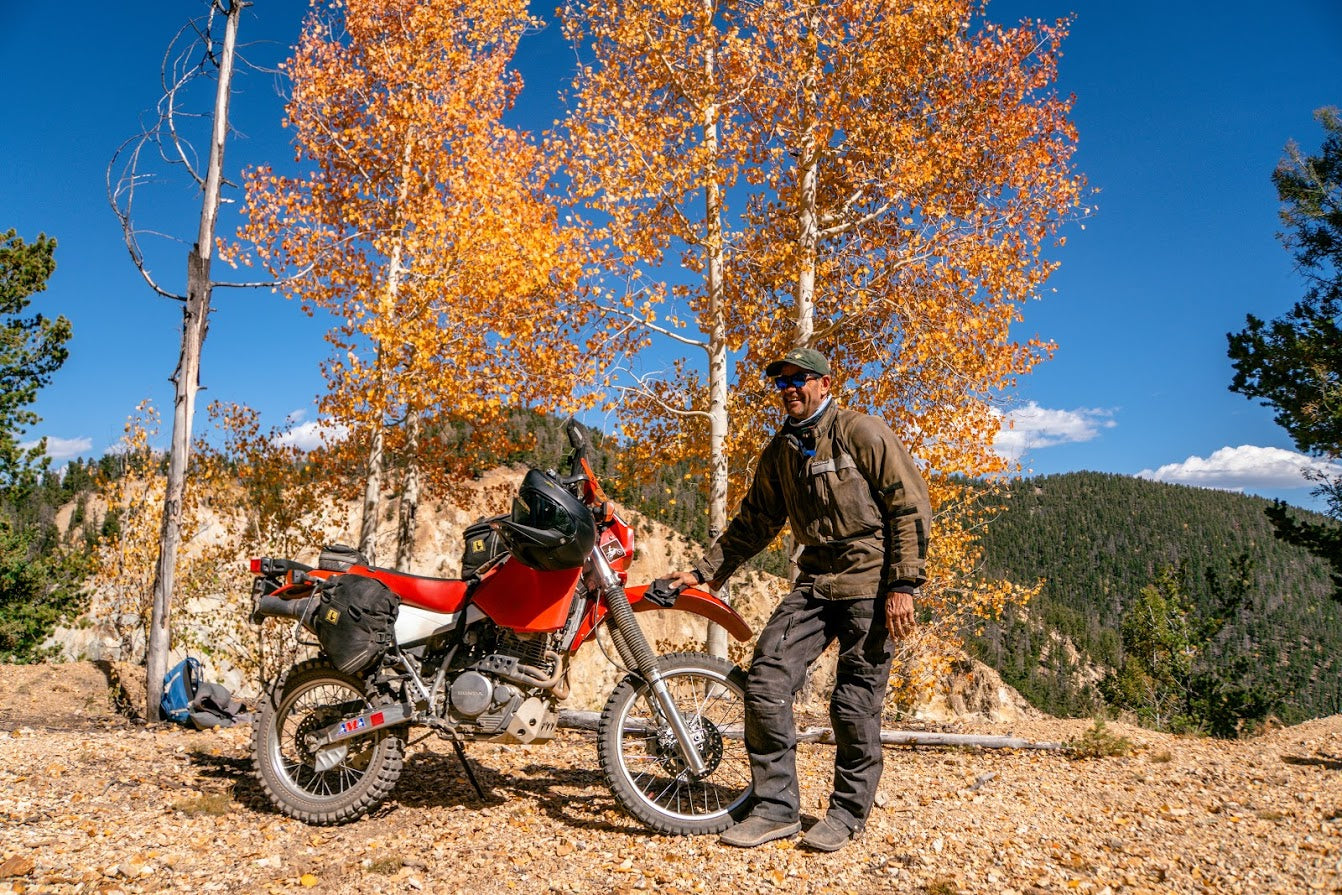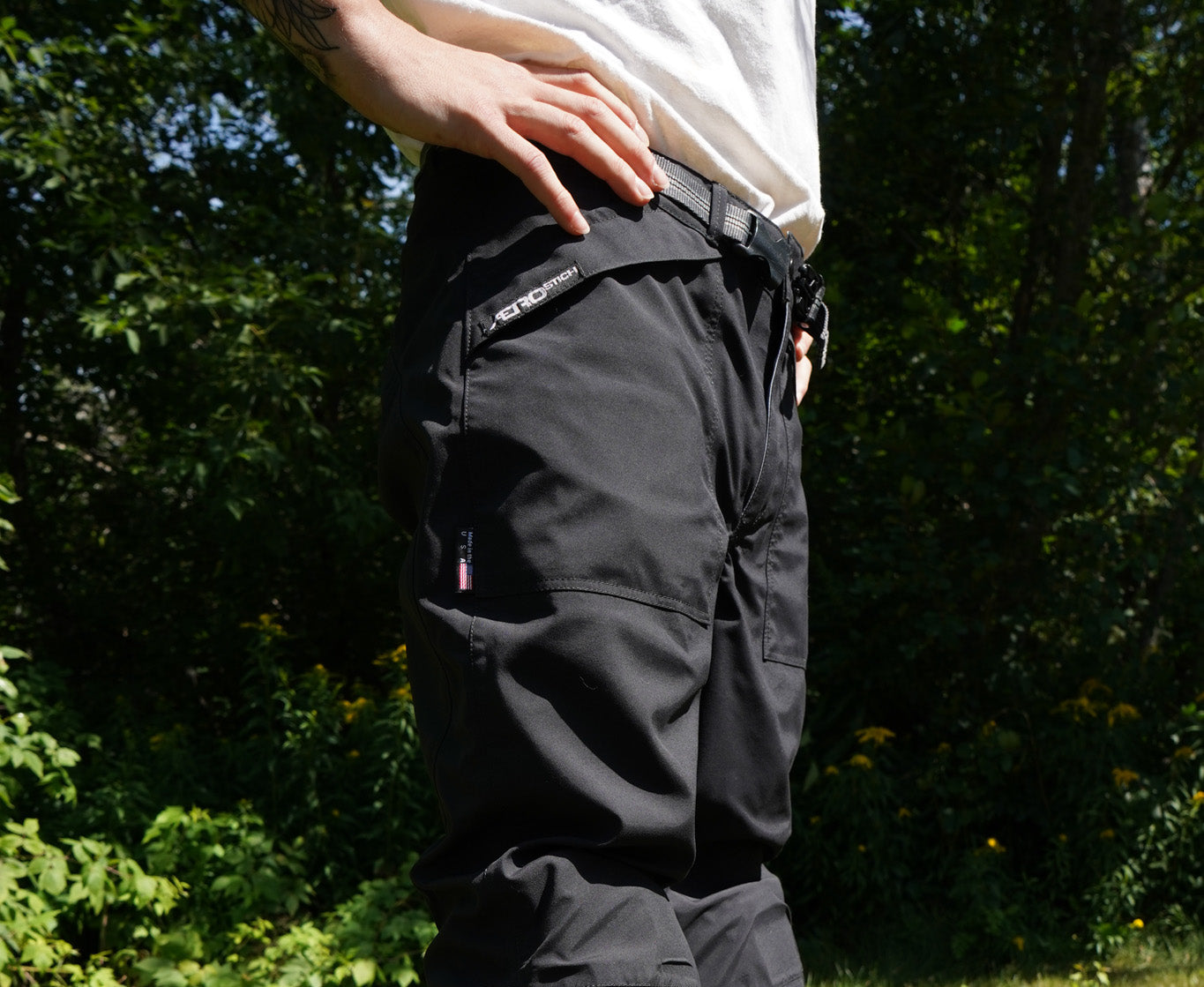Roadcrafter & Darien FAQ
Darien Versus Roadcrafter?
The Roadcrafter provides more double layers of fabric over a larger area than the Darien. These include the elbow/shoulder/knee areas of ballistics nylon and additional Roadcrafter pockets. On the other hand, the Darien is lighter and cooler to wear. Crash events most commonly occur between 30 and 70 mph. Within this range the Darien, DarienLight and Roadcrafter all provide useful abrasion protection. All three provide more than jeans and windbreaker jackets. Riders on powerful sport bikes will prefer the closer fit and greater protection a Roadcrafter suit offers. Roadcrafters are available in short, regular, and long, and Dariens are all regulars, so if you are extra short or tall, go with the Roadcrafter. Getting a good fit is more important than the functional differences.
For commuting around this smaller city, I often wear a DarienLight jacket, an open face helmet, denim jeans and ankle high shoes. On weekend rides, I normally wear a regular Darien outfit or Roadcrafter suit, and a full-face helmet and boots. For a day at a track school, I have only worn a Roadcrafter&with all the optional pads&something I would seldom choose for my local everyday surface-street riding here. On overnight trips, I use a Darien or DarienLight outfit, depending on where I am going, and how long the trip will be. For many years I wore only a one piece Roadcrafter everywhere, including on weeks-long road trips. That's still a favorite, but for my everyday urban riding I mostly choose a Darien. If you want a two piece suit, go with the Darien. For a one piece suit, go with the Roadcrafter. If you already have it down to these two choices and cannot make a decision, call and talk with us about your everyday riding patterns and applications.
- Mr. Subjective 2001
Delivery
Most Roadcrafter orders are shipped immediately from sizes and colors in stock, or in a few weeks for suits that are manufactured to special order. Suits that are done this way are normally shipped two to four weeks after an order is received, depending on the incoming seasonal order volume. Please call or email us if you have questions.
Mail Order Sizing and Fitting?
We are experts at providing a great fit. We've talked to thousands of riders about their size, bike, local climate and personal riding applications. We use a questionnaire to help learn the right things, so you'll get the best fit with your Roadcrafter or Darien. Our most experienced associates do this successfully about 95% of the time. Every order is double checked for accuracy. Ordering factory direct gives you access to more sizes than are available elsewhere. The one piece Roadcrafter comes in twenty-five different off-the-rack standard sizes. Let us help you find the one that provides the most perfect, precise fit. If you happen to need a different size, return the suit and we'll ship out a replacement free of charge.*
Fitting Women?
Compared to men of the same height, women usually have slightly narrower shoulders, slightly longer legs and arms, and slightly shorter torsos. Roadcrafters and Dariens are looser fitting designs. About 60% of all women find Aerostich suits fit well without alterations. Of the remaining 40%, about half of these can enjoy a good fit after minor sleeve/arm/gusset/etc...alterations. Only about 20% of women (and 10% of men) cannot be fitted within the range of available sizes and custom alterations. Fully tailor made garments are not available.
Buying Sight Unseen?
Things bought mail-order can sometimes be dissatisfying. Smaller than pictured. Or cheaply made. Or somehow just-not-nice. Aerostich was established to pioneer textile riders clothing. The RiderWearHouse catalog was created to sell riding tools and riders gear that make motorcycling better. You will find goods made with quality, integrity, long service, a little fun... and real value. When you open your package, we want your order to be better than you expected. We want your business and value your trust.
Maintaining Breathable Fabrics?
After the manufacturing process that bonds a breathable/waterproof membrane to Cordura fabric, a DWR (Durable Water Repellent) chemical treatment is applied that prevents water from being absorbed into the Cordura’s fibers. If the Cordura fibers become saturated in wet conditions, the water forms a barrier causing vapor to condense on the inside surface. Over time and after extended wear, the original DWR treatment wears away and must be renewed. Periodically laundering gear with a wash-in treatment like Nikwax TX Direct®, or applying a post-wash water repellent product like Scotchgard®, Revivex® or Tectron®, will insure that water beads and runs off the fabric, and that vapor will always be able to pass through, even in wet conditions. Maintaining the DWR also helps textile gear dry faster after being in rain.
Cleaning/Laundering?
Machine washing is recommended. Remove the TF2 pads and the contents of all the pockets. Close all zippers. Use the regular wash cycle, and a 'warm' water setting with mild powder detergent, wash-in water repellent products, or non-detergent soaps formulated specifically for outdoor fabrics. Run the complete wash/rinse cycle a second or third time with water only to remove any residual detergent. Machine dry at a medium temperature. Do not use anti-static products. Velcro® hook fasteners pick up lint so avoid laundering with cotton towels. Clean Velcro hook using a fine comb. Small stains can be removed using spot cleaning stain removal products. Citrus based cleaners work well for oil stains.
Waterproofing Zippers?
The Roadcrafter’s unique zipper arrangement can become a source of water entry in extremely wet conditions. To dramatically improve performance in severe conditions use either a wash-in water repellent or hand seal these areas: 1) Stitching and knit zipper fabric around both underarm zips; 2.) The knit zipper fabric along the right leg zipper; 3.) The stitching and knit zipper fabric along the left leg zipper from two inches above the bottom of the Velcro flap, to below the knee.
Wash-in repellents like Nikwax TX Direct® penetrate everywhere during laundering. In addition to improving breathability in wet conditions, they minimize leaks around zippers. Seam sealing products like Seam Grip®, should be thinned enough to completely soak into the fabric, thread, and stitching. (Use Cotol® or toulene.) Apply sealant to both the knit zipper fabric and the stitching.
Color Durability?
Weather and strong sunlight may cause some fading of fabric color dyes. Similar fading occurs in all types of clothing from leathers to blue jeans. This is normal wear and does not affect the strength, waterproofness or overall performance of textile garments. Red dyes show color loss fastest. Fading can be minimized by washing with milder soaps, drying at lower temperatures and occasionally re-applying a water and stain repellent or a UV inhibitor product like UV Tech®.
Crash and Abrasion Considerations?
Compared to leather of the same weight and thickness, Cordura nylon is a stronger material. But hides are thicker and heavier so they offer greater abrasion resistance. We repair about twenty or thirty Aerostich garments a month. About a third of these were in crashes that produced some abrasion damage. Several common themes have emerged. Though Aerostich suits are not as abrasion resistant as racing leathers, they offer significant and useful protection, especially at typical street speeds.
Aerostich wearers often think of their suit as sacrificial in the same way a car's airbag gets used up by its deployment. These garments are lighter, cooler and easier to use in bad weather (etc...), but less crash-durable than leathers. On average, street riders seem to crash only at infrequent intervals. How gear feels and works during the intervening years of use and the tens of thousands of miles of riding is very important. Most street crashes occur between 20 and 50 mph, not between 50 and 100. For each Roadcrafter suit that was in a 100 mph crash, we get dozens that need smaller repairs because the rider fell down at 35 mph . For these kinds of everyday spills, even the fanciest leathers do not offer protective advantages. We make gear to help you use a motorcycle more and be better protected. It has to be safe, easy to use, and comfortable for everyday riding.
Nylon and Friction?
Although we have not conducted tests comparing the friction coefficients of cordura suits and leathers on various pavement surfaces, we have collected a significant amount of relevant information. We repair many Aerostich suits every year, and most of these are damaged by sliding on all kinds of pavements. Many of the wearers (testers....?) had previous crash experiences with leathers. Post-crash wearers typically comment that their Aerostich was 'slipperier' than their old leathers. The consensus is that Cordura slides a little better and tends to roll and tumble the wearer somewhat less than leather. After studying hundreds of accidents, former Motorcyclist magazine editor and professional accident reconstructionist Gordon Jennings believed that more crash injuries (broken shoulders, etc..) were caused by tumbling than by the incrementally increased chances of hitting something due to sliding farther.
'CE Approved' Labels?
CE impact standards involve both energy absorption capability and pad shape and size. Aerostich TF2 pads do not match these European standards because of their shapes, not their energy absorption capabilities. In hard-shelled areas, TF2 armor tested significantly better than most other CE approved armor. Around the softer edges, it tests lower. TF2 armor was tested at a CE lab in England and using a duplicate of the test apparatus here. TF2 pads were developed (years before CE standards existed) to provide effective protection when fitted into the oversuit designs of Roadcrafters and Dariens. Because of this, TF2 pads allow comfort with various combinations of street clothing better than CE shapes. Roadcrafter suits were the first riders garments to use removable armor pad systems,and to use an advanced energy absorbing material like TF2. When we introduced TF2 armor, all protective garments, including road racing suits, featured sewn-in paddings made from felt, foam rubber or other less effective materials.
Legal Notice: These garments are not considered to be personal protective equipment as defined in or within the scope of, the personal protective equipment (EC Directive) regulations 1992 (S.I.1992/3139) and no liability will be accepted arising out of these garments non-compliance with such regulations.
*Available to US customers only.















